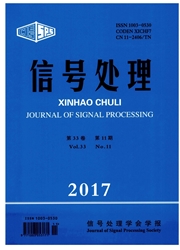

 中文摘要:
中文摘要:
为了得到稳定的波束方向图、进一步提高极化敏感阵列的滤波性能,文中提出了一种极化域-空域联合的四元数幅度相位估计(Q-APES,Quaternion-Amplitude and Phase EStimation)自适应波束形成算法。首先,利用四元数信号模型很好的保持了两分量阵列各阵元输出信号分量之间固有的正交特性,使得该模型较传统的长矢量模型更适合于极化敏感阵列信号处理。然后,将纯空域的APES算法拓展到极化域-空域联合处理中,给出了Q-APES算法的理论推导和分析,得出了四元数最优滤波权向量,并通过仿真实验验证了文中算法的有效性。计算机仿真结果表明,在强期望信号、低采样快拍数或是入射干扰信号与期望信号相干的情况下,文中算法都可以很好的实现极化域-空域联合自适应滤波。
 英文摘要:
英文摘要:
In order to obtain a stable beam pattern and further improve the performance of adaptive beamforming for polarization sensitive array, a Quaternion-Amplitude and Phase Estimation (Q-APES) algorithm is presented for polarizationspace adaptive fi],tering in the paper. First, the quaternion signal model is given and the inherent orthogonal structure of the two component signal output of each sensor has been kept well by using the quaternion signal model. It is obvious that the quaternion signal model is more suitable for two component vector sensor array signal processing than the conventional long vector signal model which is based on the complex number. Second, the conventional APES algorithm for spatial domain filtering has been expanded to the polarization-space adaptive beamforming. The proposed Q-APES algorithm is derived theoretically and the quaternion optimal weight vector is obtained following. Finally, computer simulation results are shown to verify the correctness of the proposed algorithm. The results indicate that Q-APES algorithm can achieve a better filtering performance than the existing Q-MVDR algorithm under the circumstances of strong desired signal power or low sampling snapshot numbers. Moreover, Q-APES algorithm can also perform well even if the incident interference signals are fully correlated with the desired signal.
 同期刊论文项目
同期刊论文项目
 同项目期刊论文
同项目期刊论文
 期刊信息
期刊信息
